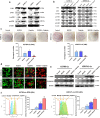Inhibition of PI3K/Akt/mTOR signaling pathway alleviates ovarian cancer chemoresistance through reversing epithelial-mesenchymal transition and decreasing cancer stem cell marker expression
- PMID: 31234823
- PMCID: PMC6591840
- DOI: 10.1186/s12885-019-5824-9
Inhibition of PI3K/Akt/mTOR signaling pathway alleviates ovarian cancer chemoresistance through reversing epithelial-mesenchymal transition and decreasing cancer stem cell marker expression
Abstract
Background: Ovarian cancer is the most common malignant tumor of the female reproductive tract. Chemoresistance is a major challenge for current ovarian cancer therapy. However, the mechanism underlying epithelial ovarian cancer (EOC) chemoresistance is not completely uncovered. The phosphatidylinositol-3-kinase (PI3K)/Akt/mammalian target of rapamycin (mTOR) signaling is an important intracellular pathway in regulating cell cycle, quiescence, and proliferation. The aim of this study is to investigate the role of PI3K/Akt/mTOR signaling pathway and its association with epithelial-mesenchymal transition (EMT) and cancer stem cell (CSC) marker expression in EOC chemoresistance.
Methods: The expressions of EMT and CSC markers were detected by immunofluorescence, western blot, and quantitative real-time PCR. BEZ235, a dual PI3K/mTOR inhibitor, was employed to investigate the role of PI3K/Akt/ mTOR signaling in regulating EMT and CSC marker expression. Students' t test and one-way ANOVA with Tukey's post-hoc test were used to compare the data from different groups.
Results: We found that EMT and CSC marker expression were significantly enhanced in chemoresistant EOC cells, which was accompanied by the activation of PI3K/Akt/mTOR signaling. Compared with single cisplatin treatment, combined treatment with BEZ235 and cisplatin significantly disrupted the colony formation ability, induced higher ROS level and more apoptosis in chemoresistant EOC cells. Furthermore, the combination approach effectively inhibited PI3K/Akt/mTOR signaling pathway, reversed EMT, and decreased CSC marker expression in chemoresistant EOC cells compared with cisplatin mono-treatment.
Conclusions: Our results first demonstrate that EMT and enhanced CSC marker expression triggered by activated PI3K/Akt/mTOR signaling are involved in the chemoresistance of EOC, and BEZ235 in combination with cisplatin might be a promising treatment option to reverse EOC chemoresistance.
Keywords: CSC; Chemoresistance; EMT; Ovarian cancer; PI3K/Akt/mTOR signaling.
Conflict of interest statement
The authors declare that they have no competing interests.
Figures





Similar articles
-
Acquisition of epithelial-mesenchymal transition and cancer stem cell phenotypes is associated with activation of the PI3K/Akt/mTOR pathway in prostate cancer radioresistance.Cell Death Dis. 2013 Oct 24;4(10):e875. doi: 10.1038/cddis.2013.407. Cell Death Dis. 2013. PMID: 24157869 Free PMC article.
-
Lysine demethylase 2A promotes the progression of ovarian cancer by regulating the PI3K pathway and reversing epithelial‑mesenchymal transition.Oncol Rep. 2019 Feb;41(2):917-927. doi: 10.3892/or.2018.6888. Epub 2018 Nov 27. Oncol Rep. 2019. PMID: 30483796 Free PMC article.
-
Activation of endoplasmic reticulum stress promotes autophagy and apoptosis and reverses chemoresistance of human small cell lung cancer cells by inhibiting the PI3K/AKT/mTOR signaling pathway.Oncotarget. 2016 Nov 22;7(47):76827-76839. doi: 10.18632/oncotarget.12718. Oncotarget. 2016. Retraction in: Oncotarget. 2019 Jun 25;10(41):4252. doi: 10.18632/oncotarget.27064. PMID: 27765907 Free PMC article. Retracted.
-
The impact of microRNA-mediated PI3K/AKT signaling on epithelial-mesenchymal transition and cancer stemness in endometrial cancer.J Transl Med. 2014 Aug 21;12:231. doi: 10.1186/s12967-014-0231-0. J Transl Med. 2014. PMID: 25141911 Free PMC article. Review.
-
Association of the Epithelial-Mesenchymal Transition (EMT) with Cisplatin Resistance.Int J Mol Sci. 2020 Jun 3;21(11):4002. doi: 10.3390/ijms21114002. Int J Mol Sci. 2020. PMID: 32503307 Free PMC article. Review.
Cited by
-
Long Non-coding RNA DLEU2L Targets miR-210-3p to Suppress Gemcitabine Resistance in Pancreatic Cancer Cells via BRCA2 Regulation.Front Mol Biosci. 2021 Apr 22;8:645365. doi: 10.3389/fmolb.2021.645365. eCollection 2021. Front Mol Biosci. 2021. PMID: 33968986 Free PMC article.
-
Defining the Role of Metastasis-Initiating Cells in Promoting Carcinogenesis in Ovarian Cancer.Biology (Basel). 2023 Dec 5;12(12):1492. doi: 10.3390/biology12121492. Biology (Basel). 2023. PMID: 38132318 Free PMC article. Review.
-
Transcriptomic Analysis of Diffuse Intrinsic Pontine Glioma (DIPG) Identifies a Targetable ALDH-Positive Subset of Highly Tumorigenic Cancer Stem-like Cells.Mol Cancer Res. 2021 Feb;19(2):223-239. doi: 10.1158/1541-7786.MCR-20-0464. Epub 2020 Oct 26. Mol Cancer Res. 2021. PMID: 33106374 Free PMC article.
-
How to win the ovarian cancer stem cell battle: destroying the roots.Cancer Drug Resist. 2020 Dec 22;3(4):1021-1033. doi: 10.20517/cdr.2020.93. eCollection 2020. Cancer Drug Resist. 2020. PMID: 35582216 Free PMC article. Review.
-
Targeting the PI3K/AKT/mTOR pathway in epithelial ovarian cancer, therapeutic treatment options for platinum-resistant ovarian cancer.Cancer Drug Resist. 2021 Apr 14;4(3):573-595. doi: 10.20517/cdr.2021.05. eCollection 2021. Cancer Drug Resist. 2021. PMID: 35582310 Free PMC article. Review.
References
-
- Taube JH, Herschkowitz JI, Komurov K, Zhou AY, Gupta S, Yang J, Hartwell K, Onder TT, Gupta PB, Evans KW, et al. Core epithelial-to-mesenchymal transition interactome gene-expression signature is associated with claudin-low and metaplastic breast cancer subtypes. Proc Natl Acad Sci U S A. 2010;107(35):15449–15454. doi: 10.1073/pnas.1004900107. - DOI - PMC - PubMed
MeSH terms
Substances
Grants and funding
LinkOut - more resources
Full Text Sources
Molecular Biology Databases
Miscellaneous

